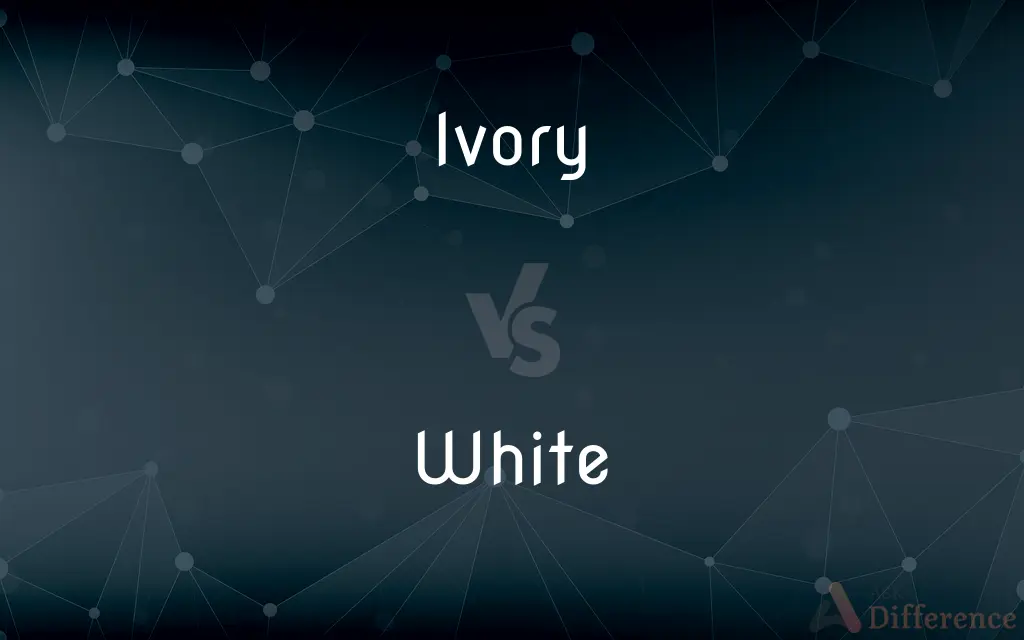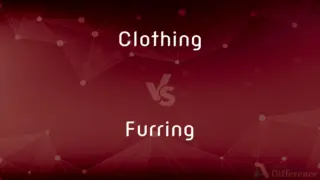Ivory vs. White — What's the Difference?
Edited by Tayyaba Rehman — By Maham Liaqat — Updated on March 25, 2024
Ivory is a soft white with a slight tint of yellow or cream, often associated with natural materials, while white is pure and bright, representing light in its most complete spectrum.

Difference Between Ivory and White
Table of Contents
ADVERTISEMENT
Key Differences
Ivory, named after the material derived from elephant tusks and other animal teeth, exhibits a warm, slightly yellowish or creamy hue. This color is often associated with elegance and natural beauty, reflecting a subtle richness not found in stark white. In contrast, white is the culmination of all colors of light, perceived when the retina receives a full spectrum of visible wavelengths, symbolizing purity, cleanliness, and simplicity.
In interior design, ivory is preferred for its warmth and ability to create a cozy and inviting atmosphere, making spaces feel more lived-in and welcoming. It pairs well with a wide range of colors, adding a touch of elegance without the clinical feel that pure white sometimes imparts. Whereas white is favored for its ability to reflect light and make spaces appear larger and brighter, often used in modern and minimalist designs to evoke a sense of purity and openness.
In fashion, ivory is a popular choice for garments that aim for a classic, timeless look, such as wedding dresses and formal wear, where its subtle warmth enhances the wearer's natural glow. On the other hand, white is chosen for its stark contrast and bold simplicity, often used in designs that aim to make a fresh, clean, or bold statement.
The perception of ivory versus white can also vary culturally. In some cultures, ivory conveys luxury and status, historically valued for its rarity and association with precious materials. White, however, can represent a wide range of concepts from peace and purity to mourning and simplicity, depending on cultural contexts.
In the art and design world, the choice between ivory and white can significantly affect the mood and message of a piece. Ivory's warmth suggests a sense of history and durability, often used in works that aim to evoke a sense of tradition or antiquity. White, with its brightness and neutrality, is frequently used to convey modernity, clarity, and precision, serving as a blank canvas that highlights other colors or elements.
ADVERTISEMENT
Comparison Chart
Hue
Soft white with yellow or cream tint
Pure, bright white
Association
Elegance, warmth, natural beauty
Purity, cleanliness, simplicity
Interior Design
Creates a cozy, inviting atmosphere
Reflects light, makes spaces appear larger
Fashion
Classic, timeless appeal
Fresh, clean, bold statement
Cultural Symbolism
Luxury, status
Peace, purity, or mourning
Art and Design
Suggests tradition, durability
Conveys modernity, clarity, precision
Compare with Definitions
Ivory
Derived from elephant tusks and other animal teeth.
Ivory carvings are highly valued but controversial due to conservation issues.
White
Chosen for its ability to make spaces feel larger and brighter.
They painted the small room white to make it appear more spacious.
Ivory
Symbolizing elegance and natural warmth.
The ivory walls added a cozy feel to the living room.
White
The brightest color, reflecting all visible wavelengths of light.
The white walls reflected the sunlight, brightening the entire room.
Ivory
Often associated with luxury and rarity.
The antique piano had ivory keys, indicative of its age and value.
White
Symbolizing purity, cleanliness, and simplicity.
The white linens gave the room a fresh, clean look.
Ivory
A warm, slightly yellowish white color.
The bride chose an ivory dress for its classic beauty.
White
Can represent peace or mourning, depending on the culture.
In some cultures, white is worn at funerals to symbolize mourning.
Ivory
Preferred for its subtle and warm hue in design.
They chose ivory curtains to complement the room's earth tones.
White
Common in modern and minimalist designs.
The designer used white space effectively to create a minimalist aesthetic.
Ivory
Ivory is a hard, white material from the tusks (traditionally from elephants) and teeth of animals, that consists mainly of dentine, one of the physical structures of teeth and tusks. The chemical structure of the teeth and tusks of mammals is the same, regardless of the species of origin.
White
White is the lightest color and is achromatic (having no hue). It is the color of fresh snow, chalk, and milk, and is the opposite of black.
Ivory
A hard creamy-white substance composing the main part of the tusks of an elephant, walrus, or narwhal, often (especially formerly) used to make ornaments and other articles
A dagger with an ivory handle
White
The achromatic color of maximum lightness; the color of objects that reflect nearly all light of all visible wavelengths; the complement or antagonist of black, the other extreme of the neutral gray series. Although typically a response to maximum stimulation of the retina, the perception of white appears always to depend on contrast.
Ivory
The creamy-white colour of ivory
An ivory silk blouse
White
The albumen of an egg.
Ivory
A hard, smooth, yellowish-white substance composed primarily of dentin that forms the tusks of the elephant.
White
The white part of an eyeball.
Ivory
A similar substance forming the tusks or teeth of certain other mammals, such as the walrus.
White
A blank or unprinted area, as of an advertisement.
Ivory
A tusk, especially an elephant's tusk.
White
Whites Pieces of laundry having a white or nearly white color.
Ivory
An article made of ivory.
White
Whites White pants or a white outfit of a special nature
Tennis whites.
Ivory
A substance resembling ivory.
White
Whites The white dress uniform of the US Navy or Coast Guard.
Ivory
A pale or grayish yellow to yellowish white.
White
A white wine.
Ivory
(Music) Piano keys.
White
A white pigment.
Ivory
(Games) Dice.
White
A white breed, species, or variety of animal.
Ivory
(Slang) The teeth.
White
Any of various butterflies of the subfamily Pierinae, characteristically having chiefly white wings often with black markings.
Ivory
Composed or constructed of ivory.
White
Also White A member of a racial group having light-colored skin, especially when of European origin and in some classifications also when of Middle Eastern or North African origin.
Ivory
Of a pale or grayish yellow to yellowish white.
White
Often whites Products of a white color, such as flour, salt, and sugar.
Ivory
(uncountable) The hard white form of dentin which forms the tusks of elephants, walruses and other animals.
White
The white or light-colored pieces, as in chess.
Ivory
A creamy white color, the color of ivory.
White
The player using these pieces.
Ivory
Something made from or resembling ivory.
White
The outermost ring of an archery target.
Ivory
The teeth.
White
A hit in this ring.
Ivory
The keys of a piano.
To tickle the ivories
White
Whites(Medicine) Leukorrhea.
Ivory
(slang) A white person.
White
White A member of a conservative or counterrevolutionary faction, especially one opposing the Bolsheviks in the Russian civil war.
Ivory
(informal) A die object bearing numbers, thrown in games of chance.
White
Being of the color white; devoid of hue, as new snow.
Ivory
Made of ivory.
White
Weakly colored; almost colorless; pale
White wine.
Ivory
Resembling or having the colour of ivory.
White
Pale gray; silvery and lustrous
White hair.
Ivory
The hard, white, opaque, fine-grained substance constituting the tusks of the elephant. It is a variety of dentine, characterized by the minuteness and close arrangement of the tubes, as also by their double flexure. It is used in manufacturing articles of ornament or utility.
White
Light or whitish in color or having light or whitish parts. Used with animal and plant names.
Ivory
The tusks themselves of the elephant, etc.
White
Also White Of or belonging to a racial group of people having light-colored skin, especially when of European origin, and in some classifications also when of Middle Eastern or North African origin
Voting patterns within the white population.
Ivory
Any carving executed in ivory.
White
Habited in white
White nuns.
Ivory
Teeth; as, to show one's ivories.
White
Accompanied by or mantled with snow
A white Christmas.
Ivory
A hard smooth ivory colored dentine that makes up most of the tusks of elephants and walruses
White
Incandescent
White flames.
Ivory
A shade of white the color of bleached bones
White
Intensely heated; impassioned
White with fury.
White
White Of or relating to a conservative or counterrevolutionary faction, especially one opposing the Bolsheviks in the Russian civil war.
White
With milk added. Used of tea or coffee.
White
(Archaic) Unsullied; pure.
White
(Printing) To cover or make illegible with white coloring. Often used with out.
White
Bright and colourless; reflecting equal quantities of all frequencies of visible light.
Write in black ink on white paper.
White
(sometimes capitalized) Of or relating to Caucasians, people of European descent with light-coloured skin.
White
Designated for use by Caucasians.
White drinking fountain
White hospital
White
Relatively light or pale in colour.
White wine
White grapes
White birch
White
Pale or pallid, as from fear, illness, etc.
White
Lacking coloration (tan) from ultraviolet light; not tanned.
White
Affected by leucism.
White
(of coffee or tea) Containing cream, milk, or creamer.
White
The standard denomination of the playing pieces of a board game deemed to belong to the white set, no matter what the actual colour.
The white pieces in this set are in fact made of light green glass.
White
Pertaining to an ecclesiastical order whose adherents dress in white habits; Cistercian.
White
Honourable, fair; decent.
White
Grey, as from old age; having silvery hair; hoary.
White
(archaic) Characterized by freedom from that which disturbs, and the like; fortunate; happy; favourable.
White
(obsolete) Regarded with especial favour; favourite; darling.
White
(politics) Pertaining to constitutional or anti-revolutionary political parties or movements.
White
(of tea) Made from immature leaves and shoots.
White
(typography) Not containing characters; see white space.
White
(typography) Said of a symbol or character outline, not solid, not filled with color. Compare said of a character or symbol filled with color.
White
Characterised by the presence of snow.
A white Christmas
A white Easter
White
(of a set of armor) Alwhite, pertaining to white armor.
White
The color/colour of snow or milk; the colour of light containing equal amounts of all visible wavelengths.
White
A person of European descent with light-coloured skin.
White
Any butterfly of the subfamily Pierinae in the family Pieridae.
White
White wine.
White
White coffee
White
(countable) Any object or substance that is of the color white.
White
The albumen of bird eggs (egg white).
White
(anatomy) The sclera, white of the eye.
White
The cue ball in cue games.
White
Cocaine
White
The snow- or ice-covered "green" in snow golf.
White
A white pigment.
Venice white
White
A white bean
White
(archery) The central part of the butt, which was formerly painted white; the centre of a mark at which a missile is shot.
White
The enclosed part of a letter of the alphabet, especially when handwritten.
White
A feather, from the wing of the cock ostrich, that is of the palest possible shade.
White
(transitive) To make white; to whiten; to bleach.
White
Reflecting to the eye all the rays of the spectrum combined; not tinted with any of the proper colors or their mixtures; having the color of pure snow; snowy; - the opposite of black or dark; as, white paper; a white skin.
White as the whitest lily on a stream.
White
Having the color of purity; free from spot or blemish, or from guilt or pollution; innocent; pure.
White as thy fame, and as thy honor clear.
No whiter page than Addison's remains.
White
Gray, as from age; having silvery hair; hoary.
Your high engendered battles 'gainst a headSo old and white as this.
White
Characterized by freedom from that which disturbs, and the like; fortunate; happy; favorable.
On the whole, however, the dominie reckoned this as one of the white days of his life.
White
Regarded with especial favor; favorite; darling.
Come forth, my white spouse.
I am his white boy, and will not be gullet.
Driving their cattle continually with them, and feeding only upon their milk and white meats.
A pistol charged with white powder.
White
Something having the color of snow; something white, or nearly so; as, the white of the eye.
White
Specifically, the central part of the butt in archery, which was formerly painted white; the center of a mark at which a missile is shot.
'T was I won the wager, though you hit the white.
White
A person with a white skin; a member of the white, or Caucasian, races of men.
White
A white pigment; as, Venice white.
White
Any one of numerous species of butterflies belonging to Pieris, and allied genera in which the color is usually white. See Cabbage butterfly, under Cabbage.
White
To make white; to whiten; to whitewash; to bleach.
Whited sepulchers, which indeed appear beautiful outward, but are within full of . . . uncleanness.
So as no fuller on earth can white them.
White
A member of the Caucasoid race
White
The quality or state of the achromatic color of greatest lightness (bearing the least resemblance to black)
White
Australian writer (1912-1990)
White
United States political journalist (1915-1986)
White
United States architect (1853-1906)
White
United States writer noted for his humorous essays (1899-1985)
White
United States educator who in 1865 (with Ezra Cornell) founded Cornell University and served as its first president (1832-1918)
White
A tributary of the Mississippi River that flows southeastward through northern Arkansas and southern Missouri
White
(board games) the lighter pieces
White
(usually in the plural) trousers
White
Turn white;
This detergent will whiten your laundry
White
Being of the achromatic color of maximum lightness; having little or no hue owing to reflection of almost all incident light;
As white as fresh snow
A bride's white dress
White
Of or belonging to a racial group having light skin coloration;
Voting patterns within the white population
White
Free from moral blemish or impurity; unsullied;
In shining white armor
White
Marked by the presence of snow;
A white Christmas
The white hills of a northern winter
White
Restricted to whites only;
Under segregation there were even white restrooms and white drinking fountains
A lily-white movement which would expel Negroes from the organization
White
Glowing white with heat;
White flames
A white-hot center of the fire
White
Benevolent; without malicious intent;
White magic
A white lie
That's white of you
White
Of a surface; not written or printed on;
Blank pages
Fill in the blank spaces
A clean page
Wide white margins
White
(of coffee) having cream or milk added
White
Dressed (or especially habited) in white;
White nuns
White
(of hair) having lost its color;
The white hairs of old age
White
Of summer nights in northern latitudes where the sun barely sets;
White nights
Common Curiosities
Why is ivory considered elegant?
Ivory's slight yellow or cream tint and its association with natural and rare materials contribute to its perception as elegant.
What is the main difference between ivory and white?
The main difference is in their hue; ivory has a warm, creamy tint, while white is pure and bright.
What does white symbolize in different cultures?
White's symbolism varies, representing everything from purity and peace to mourning and simplicity, depending on the culture.
Can ivory and white be used interchangeably in design?
While both can be used in design, they create different atmospheres; ivory adds warmth and elegance, whereas white offers purity and simplicity.
How do cultural perceptions of ivory and white influence their use in ceremonies?
Cultural values and symbolism influence choices in ceremonies, with ivory signifying luxury and white varying from purity to mourning.
Is white always the best choice for making a space appear larger?
Yes, white is often the best choice for expanding a space's appearance due to its ability to reflect light.
Why is ivory more preferred in traditional designs?
Ivory's warmth and subtlety lend themselves well to traditional designs, emphasizing elegance and depth.
How do interior designers decide between using ivory and white?
Designers consider the desired atmosphere, with ivory creating a cozy feel and white enhancing brightness and space.
Can the use of ivory in art convey a specific era or style?
Yes, ivory can evoke a sense of tradition or antiquity, suggesting a connection to history or natural beauty.
Can the use of white in a design be overwhelming?
Yes, excessive use of white can create a sterile or too-bright environment, lacking warmth or character.
Why might a bride choose an ivory over a white wedding dress?
A bride might choose ivory for its natural warmth and elegance, especially if it complements her skin tone better than stark white.
How do ivory and white affect the perception of space and light?
Ivory adds warmth and depth, enhancing coziness, while white maximizes light reflection, making spaces appear larger and brighter.
How does the choice between ivory and white affect fashion?
The choice affects the mood and style; ivory brings classic warmth, while white stands out for its clean, bold simplicity.
In what situations is white considered a symbol of mourning?
In some Eastern cultures, white is worn at funerals and is considered a symbol of mourning, contrasting with its Western associations with purity and weddings.
Is white suitable for every room in a house?
While white can brighten rooms, its suitability depends on the desired aesthetic and how it complements other design elements.
Share Your Discovery

Previous Comparison
But vs. Butt
Next Comparison
Clothing vs. FurringAuthor Spotlight
Written by
Maham LiaqatEdited by
Tayyaba RehmanTayyaba Rehman is a distinguished writer, currently serving as a primary contributor to askdifference.com. As a researcher in semantics and etymology, Tayyaba's passion for the complexity of languages and their distinctions has found a perfect home on the platform. Tayyaba delves into the intricacies of language, distinguishing between commonly confused words and phrases, thereby providing clarity for readers worldwide.















































